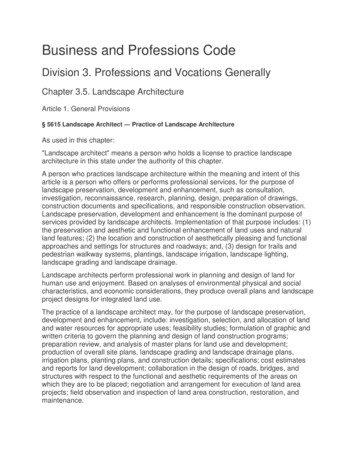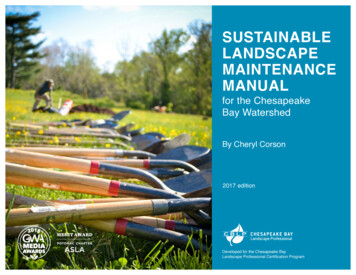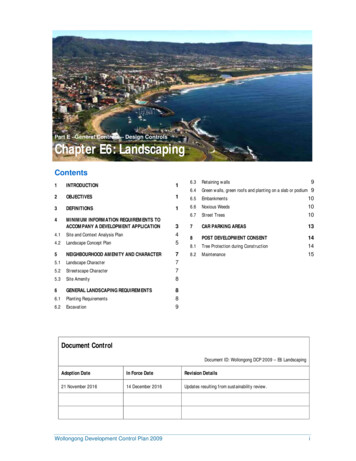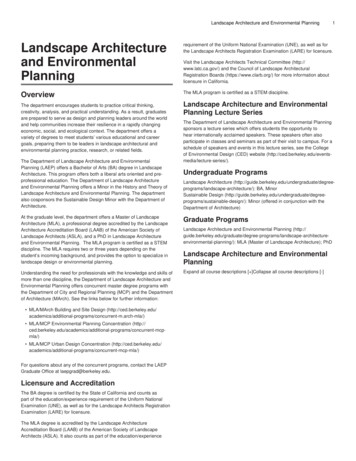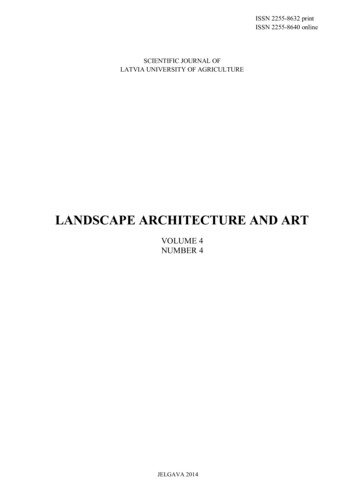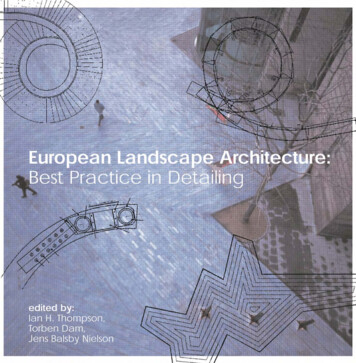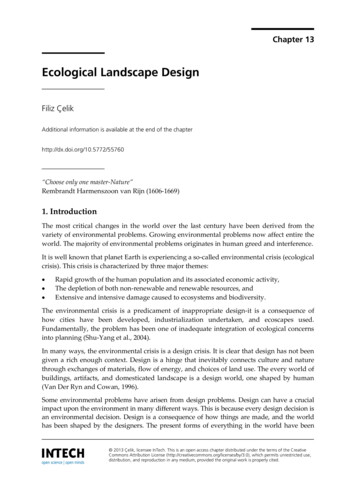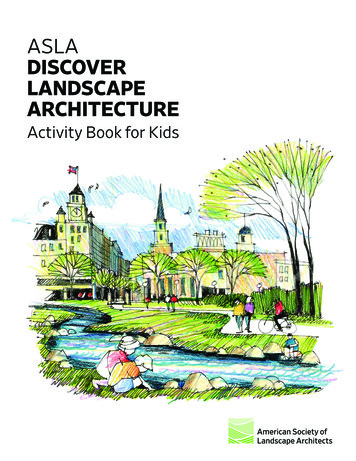
Transcription
The Changing Landscape ofHuman Subjects ResearchP. Pearl O’Rourke, MDPartners HealthCareBoston, MA
Agenda 50th Anniversary of Beecher paper– Who was Henry Beecher?– Why was his paper so important? What has happened in 50 years?– Changes in research/researchers– Changes in public perceptions Have we met Beecher’s criteria?
Henry Beecher1904-1976Named Chief ofAnesthesia atMassachusettsGeneral Hospitalin 1936
and nephritis
Beecher. 1966NEJM 1966:274:1354-1360 22 published studies with questionable ethics No names or citations given “These examples are not cited for thecondemnation of individuals; they are recordedto call attention to a variety of ethical problemsfound in experimental medicine .it has becomeapparent that thoughtlessness and carelessness,not a willful disregard of the patient’s rights,account for most of the cases encountered.”
Henry BeecherNEJM 1966:274:1354-1360 Known effective treatment withheld– Complications of streptococcal infections Example 1: 109 received placebo (not Pen) Example 2: 500 denied Pen– Relapse rate of typhoid fever Example 3: chloramphenicol withheld in 157/408 charity patients
Henry BeecherNEJM 1966:274:1354-1360 Study of therapy– Example 4– TriA (triacetyloleandomycin)– Study of hepatic toxicity in 50 patients 13-39 yo; some with mental deficiency; some inmates at a children’scenter– Study stopped because of hepatotoxicity 8 transferred to hospital and had liver bx 4 had repeat challenge after LFT normalized 1/4 had a 2nd challenge
Henry BeecherNEJM 1966:274:1354-1360 Physiologic studies– Example 5: chloramphenicol hemato-toxicity 20 patients given 2 gm/day: 2/20 BM suppression 21 patients given 6 gm/day: 18/21 BM suppression– Example 6: effect of thymectomy on skin grafts CHD patients 3.5 mo – 18 yr 7 controls and 11 total thymectomy Full thickness skin grafts sutured to chest wall
Henry BeecherNEJM 1966:274:1354-1360 Highlightes the importance of ethical approach toresearch– Two most important components Informed consent (although difficult/if not impossible, must try) Presence of “an intelligent, informed, conscientious,compassionate, responsible investigator.” Making people aware of the problem wouldhopefully be sufficient Did not suggest regulatory oversight
Claude Bernard1813-1878Championed thescientific method.Described as “one ofthe greatest men ofscience”"Among the experiments that maybe tried on man, those that can onlyharm are forbidden, those that areinnocent are permissible, and thosethat may do good are obligatory. It isimmoral then, to make an experimenton man when it is dangerous to him,even though the result may be usefulto others. It is essentially moral tomake experiments on an animal, eventhough painful and dangerous, if theymay be useful to man." (*)http://www.claude-bernard.co.uk/page13.htm
Fun Addendum to C. BernardBernard's scientific discoveries were made throughvivisection:“The physiologist is no ordinary man. He is a learned man, a manpossessed and absorbed by a scientific idea. He does not hear theanimals' cries of pain. He is blind to the blood that flows. He seesnothing but his idea, and organisms which conceal from him thesecrets he is resolved to discover.”Bernard practiced vivisection, to the disgust of his wife and daughterswho had returned at home to discover that he had vivisected theirdog. The couple was officially separated in 1869 and his wife went onto actively campaign against the practice of .htm
The importance of:-“direct benefit is likely”-“full consent”Otherwise “the sacred cordwhich blinds physician andpatient snaps instantly.”William Osler1849-1919“The father ofmodern medicine”Jones et al NEJM 374:24. p2393 2016
Walter Cannon proposed to the AMA in 1916:The need for definition of conditionsnecessary for acceptable humanexperimentation, including formal, priorpatient consent.Walter Cannon1871-1945Francis Weld Peabody1881-1927Dr. Peabody feared that the concept of patientconsent might detract from a virtuousphysician’s responsibility to act unilaterally forthe patient’s welfare. To him the character ofthe researcher was the principle issue andPeabody noted that, fortunately, those whopursued a career in scientific medicine weregenerally ‘among the more high-minded of theprofession.’ Apparently the AMA committee agreed:they failed to adopt Cannon’s resolution.”Still More Meanderings in Medical History. M. Nevins. 2013
The Nuremberg Trials
The Nuremberg Code. 1949 Ten principles No enforcement Inappropriately seen as specific to theperpetrators of the Nazi atrocities– ‘Them not us’ mentality
The Nuremberg Code. 19491. The voluntary consent of the human subject is absolutely essential.2. The experiment should be such as to yield fruitful results for the good ofsociety, unprocurable by other methods or means of study, and notrandom and unnecessary in nature.3. The experiment should be so designed and based on the results of animalexperimentation and a knowledge of the natural history of the disease orother problem under study, that the anticipated results will justify theperformance of the experiment.4. The experiment should be so conducted as to avoid all unnecessaryphysical and mental suffering and injury.5. No experiment should be conducted, where there is an a priori reason tobelieve that death or disabling injury will occur; except, perhaps, in thoseexperiments where the experimental physicians also serve as subjects.6. The degree of risk to be taken should never exceed that determined by thehumanitarian importance of the problem to be solved by the experiment.
The Nuremberg Code. 19497. Proper preparations should be made and adequate facilities provided toprotect the experimental subject against even remote possibilities ofinjury, disability, or death.8. The experiment should be conducted only by scientifically qualifiedpersons. The highest degree of skill and care should be required throughall stages of the experiment of those who conduct or engage in theexperiment.9. During the course of the experiment, the human subject should be atliberty to bring the experiment to an end, if he has reached the physical ormental state, where continuation of the experiment seemed to him to beimpossible.10. During the course of the experiment, the scientist in charge must beprepared to terminate the experiment at any stage, if he has probablecause to believe, in the exercise of the good faith, superior skill and carefuljudgement required of him, that a continuation of the experiment is likelyto result in injury, disability, or death to the experimental subject.
50 years ago Lyndon Johnson was PresidentBeginning of MedicareBest Picture: Sound of MusicSynthetic insulin produced in ChinaFDA considered “the pill” safe for human useFirst episode of Star Trek– Man trap (creatures suck salt out of human bodies)
50 years later Barack Obama is PresidentMedicare going bankrupt?Best Picture: Spotlight (not a happy musical)Synthetic biology boonIncreased access to “the morning after pill”Star Trek Beyond
What has changed? Computers and the Intranet Explosion of science and technology Public involvement
Information FlowThe printing press and the internet Before the printing press– Information ‘owned’ by the few The printing press– Democratized access to books– No longer needed the sage for information The intranet– Perhaps the printing press on steroids
Increase in Information FlowBeing connected Computing capacity and the Internet– Sharing ideas and data– Storing and analyzing data– Expanding audiences– Democratization of data– Social media and ‘on-line’ communities
Scientific Advances
The Genetic Revolution Changed the study of disease andhealth Changed diagnostics Changed therapeutic decisions Basic component of precision medicine Became therapy: gene transfer Opened up new doors– CRISPR-CAS9 (Gene editing)
Imaging Plain radiographsCT scansMRIsPositron Emission Tomography (PET)ElastographyTactile ImagingPhotoacousticThermographyFunctional near infraredspectroscopy
Synthetic Biology"Synthetic biology is an emerging area of researchthat can broadly be described as the design andconstruction of novel artificial biological pathways,organisms or devices, or the redesign of existingnatural biological systems."Source: UK Royal SocietySynthetic Biology: Mission possible:Rewriting the genetic code.J. BohannonScience. 2016Aug 19;353(6301)
lose-reinventing-genetic-cod
unveiled-1.20
Stem Cells and Cloning Dolly the sheep
Stem cells and cloning New ways to study human development New tools for studying disease Potentially new ‘replacement’ therapies– E.g., Stem cell derived beta cells for Diabetes Dopaminergic cells for Parkinson’s disease
Increase in the ‘possibilities of science’ NanotechnologyBIG DATA3-D printingAnd more
Scientific Advances Advance newEthical Questions Examples from– Genetics The results– What do they mean? Should the genome be edited?– Stem cells Embryo questions Chimeras– BIG Data and Social Media Who can access what for what?
Cautionary Tale Of GeneticTesting: You May Drop Dead!Oops, Never MindAugust 18, 2016By Carey GoldbergWBUR
Imprecise Medicine: Genetic Tests LeadTo MisdiagnosisAugust 17, 2016 by Larry Husten–Some black Americans were wrongly told they had a high riskfor hypertrophic cardiomyopathy.Precision medicine offers the promise of an accurateassessment of individual risk for serious conditions likehypertrophic cardiomyopathy (HCM). But a new reportpublished in the New England Journal of Medicine,” which theauthors describe as “a cautionary tale of broad relevance togenetic diagnosis,” makes clear that the utility of genetic testsmay be limited by the lack of diversity of people included in theunderlying genetic databases used to assess dicine-genetic-tests-lead-to-misdiagnosis/
CRISPR-CAS 9
Stem cells and cloningNew Questions Embryonic stem cells– Embryo donation Commodification of embryos– Embryo creation for research– Somatic cell nuclear transfer Commodification of eggs– Creation of chimeras Induced pluripotent stem cells– ‘Routine’ tissue donation – adequate or not
BIG Data and Social Media
Taste, Ties and Time Three year study at an ‘anonymous’ NE university Facebook profiles and university residential formsdownloaded to study how friendships and interests evolve. 1,700 profiles: gender, home state/country, major, politicalviews, network of friends, romantic preferences andcultural tastes in books, music and movies. NOTE:– Students unaware of the research– Some had configured their profile to be visible only to Facebookfriends.– Details in the profiles made it easy to determine that the“anonymous” university was, in fact, Harvard itself.
sperils-big-data-science/
OkCupid Danish researchers publically released a datasetof nearly 70,000 users of the online dating siteOkCupid, including usernames, age, gender,location, what kind of relationship (or sex) they’reinterested in, personality traits, and answers tothousands of profiling questions used by the site. When asked whether the researchers attemptedto anonymize the dataset:– “No. Data is already dy-reveals-perils-big-data-science/
Social Network Research Researchers take online content withoutinteracting with any individuals and notconsidering them human subjects In aggregate data may be used to identifyindividuals Researchers argue that the data is public
Consider Other Changes in Research The science is simply more complexEverything with a ‘genetic angle’Mining large data sets and social networksMulti-siteMulti-state if not multi-nationalPopulation studiesPrecision MedicineLearning HealthCare Systems
Learning Health Care Systems Bridging the gap between clinical care andresearch Learning from what we do Admitting that many healthcare decisions arebased on no and/or flawed data
Learning Health Care Systems Question: which of two FDA approved and similaranti-hypertensive drugs is the better choice? Both drugs used clinically, chosen by physicianpreference. No data to suggest one is better. THE STUDY:– 50:50 randomization to each drug– Randomization unit is at the primary care clinic level Eg., if your doctor works in the 5th floor clinic – you will berandomized to Drug A. Of note, your MD routinely prefers Drug B
Please vote:This is research and each patient shouldbe asked for consentThis is comparing two acceptedtherapies, consent is not required.
Please vote:This is research and each patient shouldbe asked for consentThis is comparing two acceptedtherapies, consent is not required.* If your doctor is on the 5th floor .does your vote change?
The public has also changed Democratization of science and research I want my research results returned to me– I want the research results of my family members I want to be a partner in the research– PCOR (Patient Centered Outcomes Research)– Different roles: Consultant, true partner in design, conduct and reporting Citizen Science – I can do my own research
Consider Melanie Swan, investment advisor developed smartphone app: drug efficacy related to certain genes Trial: effect of different types of vitamin B onhomocysteine levels (connected to heart-disease risk) N 7: Two forms of vitamin B ( 300 out of pocket) Design:– 2 wks of each vitamin source separated by 2 wk wash-out– Weekly homocysteine levels: results uploaded by subjects Results presented (by invitation) at Scripps ResearchInstituteWall Street Journal Dec. 3, 2011
Concerns Quality of data collection– Integrity of data collection– Potential bias (lack of blinding) Inadequate sample sizesPremature conclusionsGeneralizations from anecdotal dataFalls outside oversightPotential medical risk – participation withoutmedical supervision
Vitamin B study Ms. Swan suggested to other trial participants thatthey pursue a more professional tack—includinggetting approval from an institutional review board. No support – participants felt Ms. Swan wasintroducing too much bureaucracy.Wall Street Journal Dec. 3, 2011
Controversy at FDA: Dr. Ellis Unger “By allowing the marketing of an ineffective drug, essentially ascientifically elegant placebo, thousands of patients and theirfamilies would be given false hope in exchange for hardship andrisk,” he wrote in a July 18 dispute report. “I argue that this wouldbe unethical and counterproductive. There could also be significantand unjustified financial costs — if not to patients, to society.” He added that approval “would send the signal that politicalpressure and even intimidation — not science — guide FDAdecisions A standard this low would undercut FDA’s ability toensure that drugs that are approved are effective; it would call intoquestion much of what we do. Lowering the bar to this level wouldbe tantamount to rolling back the 1962 Kefauver-Harris DrugAmendments to the Federal Food, Drug and Cosmetic (FD&C) Act,which have served Americans well for some 54 9/19/sarepta-fdaduchenne-behind-the-decision/
Distrust in ScienceMulti-factorial Lack of understanding re: the process ofresearch Low health and science literacy Politicization of science and research
Distrust in Science 2012 NSF survey– 25% think that the sun orbits the earth 2014 AP-GFK survey– 40% doubt evolution– 50% question the Big Bang– 40% do not believe pollution climate change– 15% do not believe in efficacy of vaccinesWHY THE REJECTION OF SCIENTIFIC THEORIES?
Science vs. Politics Gets down and DirtyUSA Today 8/7/2007"Anything that doesn't fit into the politicalappointees' ideological, theological or politicalagenda is often ignored, marginalized or simplyburied," Carmona* testified.* Former Surgeon General
Politicization of Science SCAM: Scientific Certainty ArgumentationMethod– Argue for full scientific certainty – withoutcertainty it cannot be relied upon as factWilliam R. Freudenburg, Robert Gramling,Debra J. Davidson (2008) "Scientific CertaintyArgumentation Methods (SCAMs): Science andthe politics of doubt". Sociological Inquiry. Vol.78, No. 1. 2–38
SCAM"Doubt is our product since it is thebest means of competing with the'body of fact' that exists in the mindof the general public. It is also themeans of establishing a controversy."'THE REPUBLICAN WAR ON SCIENCE,' BY CHRISMOONEY", Political Science, Review by JOHNHORGAN, Published: December 18 2005Original "Doubt is our product." memo".University of California, San Francisco. 21August 1969. Retrieved 3 October 2012
Have we met Beecher’s Criteria? “An intelligent, informed, conscientious,compassionate, responsible investigator.” Informed consent No call for more regulations
Explosion of regulations True Federal Regulations– Common Rule– HIPAA– CT.gov ‘Regulations’ associated with grant award– Stem cell guidelines– Data sharing – dbGaP, many Institute-specific– Conflict of interest mandates Mandates from outside– International Council of Medical Journal Editors
Have we fixed informed consent? No May be more broken than before– Not enough focus on process– Forms are Longer More legalistic But – we still try
Are researchers more “intelligent,informed, conscientious,compassionate, responsible” UncertainResearchers must wear too many hatsToo often spend time being the coordinatorThe regulatory burden is exhausting
We still have a long to go
20 patients given 2 gm/day: 2/20 BM suppression 21 patients given 6 gm/day: 18/21 BM suppression -Example 6: effect of thymectomy on skin grafts CHD patients 3.5 mo - 18 yr 7 controls and 11 total thymectomy Full thickness skin grafts sutured to chest wall



